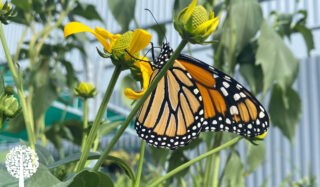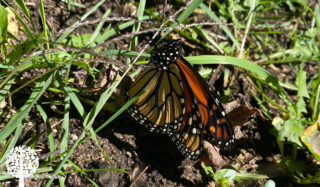This summer, my backyard was alive with monarch butterflies. Every time I saw one of the caterpillars on our milkweed or the butterflies dancing around the garden, I’d screech with delight and call the kids over to see. It’s the small things, right? By the fourth or fifth time, I could tell they were happier for me than they were about the monarch sightings. My 7-year-old son, Ryan, indulged me by saying it was cool to see since they won’t be around when he grows up. So wise, that kid.


The Endangered List
Migratory monarch butterflies are now classified as endangered by the International Union for Conservation of Nature (IUCN). Their future is at risk because of habitat destruction and climate change. In other words, because of us.
There’s still time to help them. As gardeners, we can all take small steps to provide delicious food and safe havens for our beautiful pollinator friends.
Got Milk(weed)?
When Ryan acknowledged that monarchs might not be around when he’s older, my daughter, Ella, always looking to solve problems, told me she will have a milkweed farm when she grows up. Now that’s an idea I fully support!


Last fall, Ella and I opened milkweed pods and let the seeds loose. It worked. This year, we had so much milkweed on our property. It sprung up everywhere! I understand that some people wouldn’t like this, as milkweed can be invasive. But Ella and I are all about horticultural disobedience these days.
If the wild look isn’t your thing, you can purchase milkweed seedlings (or start them from seed) and contain the plants in a raised bed or specific patch of your yard.
And although considered a weed, goldenrod is an essential food source for adult monarch butterflies, so be sure to leave some for them to enjoy!
Careful Plant Selections
My husband and I are building a new garden at the moment, and one of the things I’ve enjoyed the most through this process is coming up with my plant design. I’ve made careful selections, ensuring that more than a few plants are in bloom at all times of the growing season.


The chosen shrubs and perennials are native to my area and attract various pollinators. There’s something very satisfying about starting a garden from scratch, and I’m so excited to welcome the bees, butterflies, beneficial insects, and birds to our new space.
Here are some of the plants I’ve selected that are big butterfly attractors:
- Coneflowers (Echinacea)
- Coreopsis grandiflora
- Echinops (Veitch’s Blue Globe Thistle, Sea Holly)
- Phlox (moss phlox and tall phlox)
- Dianthus Kahori
- Achillea millefolium
- Black eyed Susans (Rudbeckia Goldsturm)
- Shasta Daisy
- Liatris Spicata
- Gaillardia aristata (Fire Wheels)
- Sedum (Autumn Joy)
- Salvia Blue Marvel
- Butterfly bush
- Meadowsweet
So many plant varieties out there attract butterflies of all kinds! The next time you’re at your local garden center, I encourage you to think about the plants various pollinators love before making your selections; read the tags and have fun with them.
And if a monarch butterfly lands on a flower you admire, or if you stumble upon one of the caterpillars, celebrate. Call the kids over and maybe take some pictures. After all, monarchs are a special and increasingly rare thing.
